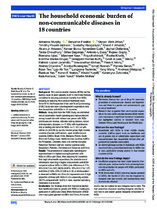The household economic burden of non- communicable diseases in 18 countries
Abstract
background Non- communicable diseases (NCDs) are the leading cause of death globally. In 2014, the United Nations committed to reducing premature mortality from NCDs, including by reducing the burden of healthcare costs. Since 2014, the Prospective Urban and Rural Epidemiology (PURE) Study has been collecting health expenditure data from households with NCDs in 18 countries. Methods Using data from the PURE Study, we estimated risk of catastrophic health spending and impoverishment among households with at least one person with NCDs (cardiovascular disease, diabetes, kidney disease, cancer and respiratory diseases; n=17 435), with hypertension only (a leading risk factor for NCDs; n=11 831) or with neither (n=22 654) by country income group: high- income countries (Canada and Sweden), upper middle income countries (UMICs: Brazil, Chile, Malaysia, Poland, South Africa and Turkey), lower middle income countries (LMICs: the Philippines, Colombia, India, Iran and the Occupied Palestinian Territory) and low- income countries (LICs: Bangladesh, Pakistan, Zimbabwe and Tanzania) and China. results The prevalence of catastrophic spending and impoverishment is highest among households with NCDs in LMICs and China. After adjusting for covariates that might drive health expenditure, the absolute risk of catastrophic spending is higher in households with NCDs compared with no NCDs in LMICs (risk difference=1.71%; 95% CI 0.75 to 2.67), UMICs (0.82%; 95% CI 0.37 to 1.27) and China (7.52%; 95% CI 5.88 to 9.16). A similar pattern is observed in UMICs and China for impoverishment. A high proportion of those with NCDs in LICs, especially women (38.7% compared with 12.6% in men), reported not taking medication due to costs. Conclusions Our findings show that financial protection from healthcare costs for people with NCDs is inadequate, particularly in LMICs and China. While the burden of NCD care may appear greatest in LMICs and China, the burden

